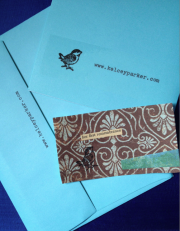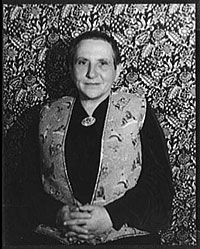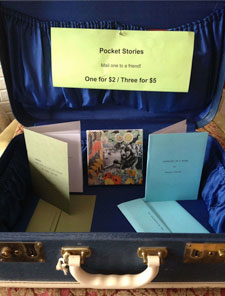Essay by Kelcey Parker
Advertising to More Than an Admiring Bog
In 2001, I wrote and published my first short story. In 2011, I published my first book, For Sale by Owner, a collection of stories named for that inaugural piece. In the ten years between, I was a grad student and a mom who coached soccer. I shuttled my daughter to violin lessons and studied for doctoral exams. I wrote, more or less, in secret.

But a year before the book came out, my publisher told me I needed a website and a blog. I had to fill out a marketing questionnaire that asked me to list everyone I’d ever met who worked at a bookstore, wrote for a newspaper, or was in a book club.
Was I on Twitter? Could I write a short bio for the press release and Amazon page? Would I invite all my friends to like the book’s Facebook page?
In other words: Get famous fast.
Okay, not famous. My book wasn’t Twilight or Harry Potter. It was fourteen strange stories published by an independent publisher of writing by women. Still, a press like that doesn’t survive for twenty years without marketing and promotion.
I’d passed a full decade in blissful ignorance of such things. Now I had to step out of my protective shell and become the public version of my secret self.
I did not go gently. I delayed and resisted. I agreed with Gertrude Stein, who, in her 1936 essay “What Are Master-pieces, and Why Are There So Few of Them?,” insisted that the emphasis on developing a public identity is what compromises artistic creation:
When you are writing before there is an audience anything written is as important as any other thing and you cherish anything and everything that you have written. After the audience begins, naturally they create something that is they create you.
For ten years, I was able to create without any awareness of my public identity as a writer. But now that I had achieved my goal—publication—I suddenly confronted a world that seemed at odds with producing meaningful art. Stein says of masterpieces:
Everything is against them. Everything that makes life go on makes identity and everything that makes identity is of necessity a necessity.

Her words made my resistance feel intellectual and full of artistic integrity. But the truth is, I was scared. I was afraid of the audience and unsure of my public self.
Fortunately, I’m not only a highbrow fan of Stein. I’m a lowbrow enthusiast of reality TV—especially The Bachelor, in which the main strategy for all contestants boils down to Put Yourself Out There!
On any given episode, you’ll see one contestant preparing for a date, “confiding” to viewers that she’s “just going to put myself out there.” After a failed date, another will lament her inability to “put myself out there.” And then there’s the one who’ll saunter back to the mansion in the wee hours, crowing: “I just put myself out there!”
I am a shy person. I have struggled my whole life to put myself out there. When it came to starting a blog or creating a web site, I didn’t even know which self to put where.
In 2010, a year before the book’s release, I launched my blog (PhD in Creative Writing) anonymously—on the Ides of March. My first post was a photo of Julius Caesar being stabbed to death. In lieu of my name, I offered a poem by Emily Dickinson, who remained a private writer until her death and is now as famous as one can be:
I’m Nobody! Who are you?
Are you – Nobody – too?
Then there’s a pair of us!
Don’t tell! they’d advertise – you know!How dreary – to be – Somebody!
How public – like a Frog –
To tell one’s name – the livelong June –
To an admiring Bog!
How dreary, indeed. Except that blogging, I soon found out, wasn’t dreary at all.
The extemporaneous feel of this kind of writing belied Stein’s words. Without the pressure of trying to create a “master-piece,” I felt free to explore and experiment in new ways. I wrote about books I loved, answered questions about writing that came up in my classes, ranted about publishers who publish mostly male writers, and posted pictures of my travels and research.
Creating myself was a lot like creating my characters, as it turned out. I had to write my way into it. I went from hoping nobody would find my blog to longing for somebody to find it. It had become dreary to be Nobody—and after several months of anonymous blogging, it was time to become Somebody: me.
The first line of Emily Dickinson’s poem is still at the top of my About page. But ironically, once I put my name on the blog, I truly enjoyed coming up with my author’s bio. I used it as a creative springboard, and the final result tells something about me from the first-, second-, and third-person points of view.
Nevertheless, as my book release got closer and closer, I continued to struggle with putting myself out there. I needed to schedule some readings. I was busy with teaching and didn’t have the time. I just wanted to write.
It’s a good thing that I discovered Alyson Stanfield’s 2008 book, I’d Rather Be in the Studio: The Artist’s Guide to Self-Promotion, when I did. Though geared toward visual artists, her book addresses the desire of all artists who would rather be creating than marketing. The book is organized by excuses she’s heard, including “There aren’t enough hours in the day to do it all,” “I don’t want to bother people,” and “I’m an introvert.”
Was this woman in my head?
Stanfield makes mincemeat of each excuse, insisting that artists are as responsible for sharing their work as for creating it. She reminds artists that they actually have something people want: insights, stories, techniques, perspectives, and skills that others are curious about. People don’t feel bothered when they learn about something they’re interested in.

So, I got busy. A few months before the release of For Sale by Owner, I teamed up with fellow writers at a local art fair. We gave a reading on a plaza downtown; between booths of jewelry and photography, we had a table of our books. But since I didn’t have a published book yet, I decided to create handmade single-story chapbooks and sell them out of a vintage suitcase. Each story fit in an envelope and could be mailed to a friend. (Some of these handmade “pocket stories”—and the suitcase—are pictured here.)
Later, I transformed my university business cards into collages with lines cut from an old edition of Othello.
I didn’t make a lot of money, but I did get lots of people interested in my work. And by the time my book came out in early 2011, I’d scheduled a dizzying array of conferences, readings, classroom visits, book clubs, and interviews with websites and campus newspapers.
That summer, as my schedule settled down a bit, I reassessed my blog and revisited Stanfield’s advice about giving people something they’re interested in. As a writing professor, I knew my students were fascinated by what it takes to become a writer. As a reader, I’ve always loved interviews with writers.
In July 2011, I started a biweekly interview series—“How to Become a Writer”—which now features interviews with more than thirty contemporary authors, each with a different story to tell. At first I begged my friends for interviews. Now I receive recommendations from readers and requests from publishers who want to promote their own authors. Most recently, I’ve collaborated with Talking Writing, interviewing TW fiction writers.
My next book is forthcoming this fall, and now my publisher wants me to brainstorm ideas for a book trailer and a release party. Liliane’s Balcony is a novella set at Frank Lloyd Wright’s Fallingwater, so perhaps we’ll have a costume party with people dressed as characters or a cake shaped like Wright’s famous house.
No matter what, I know I’ll enjoy it. DIY marketing can be fun, even for the shyest of us literary writers. It demands creativity and collaboration, and it helps connect writers and readers. For all of Stein’s laments about the “necessity of identity,” who was more successful than she at creating a dramatic artistic persona? She surrounded herself with art and artists and publicly claimed to be a genius. How’s this for a marketing idea? Have Picasso paint your portrait!
Since my first book’s release, I’ve learned to embrace all the creative aspects of the writing life, including self-promotion. And after my next book is launched, I can get back to writing—just a little less secretly.
Publishing Information
 For Sale By Owner by Kelcey Parker (Kore Press, 2011).
For Sale By Owner by Kelcey Parker (Kore Press, 2011).- “What Are Master-pieces, and Why Are There So Few of Them?” by Gertrude Stein (1936), from What Are Masterpieces (Pitman, 1940).
- “I’m Nobody! Who are you?” (poem 260) by Emily Dickinson in The Poems of Emily Dickinson, edited by Ralph W. Franklin (Harvard University Press, 1998).
- I’d Rather Be in the Studio: The Artist’s Guide to Self-Promotion by Alyson Stanfield (Pentas Press, 2008).
- “How to Become a Writer”: interview series on Kelcey Parker’s PhD in Creative Writing. The most recent co-published interview with a TW writer (Talking Writing, Nov/Dec 2012): “Ann Lightcap Bruno on Writing.”
Art Information
- "Handmade" and "Pocket Stories" © Kelcey Parker; used by permission
- Photo of Gertrude Stein, New York (November 4, 1934) by Carl Van Vechten; Library of Congress Prints and Photographs Division, Van Vechten Collection
 Kelcey Parker published her first story, “For Sale by Owner,” in GW Review in 2001. Her book For Sale By Owner went on to win the 2011 Next Generation Indie Book Award for Short Fiction and was a finalist for the 2012 Best Books of Indiana.
Kelcey Parker published her first story, “For Sale by Owner,” in GW Review in 2001. Her book For Sale By Owner went on to win the 2011 Next Generation Indie Book Award for Short Fiction and was a finalist for the 2012 Best Books of Indiana.
An excerpt of her forthcoming novella Liliane’s Balcony (Rose Metal Press, 2013) appeared in the inaugural issue of Talking Writing.
Kelcey currently blogs where the whole world can find her at PhD in Creative Writing. A few portions of this essay originally appeared, in a different form, in her December 2011 post “2011, the Year of ‘Put Yourself Out There.’”
”She must have floated across the stony platform surface. How else could she be here now at its edge, so far from the door she thought she was still clutching, leaning her torso over the low parapet to hear the waterfall.” — “Liliane’s Balcony: A Novella of Fallingwater”
